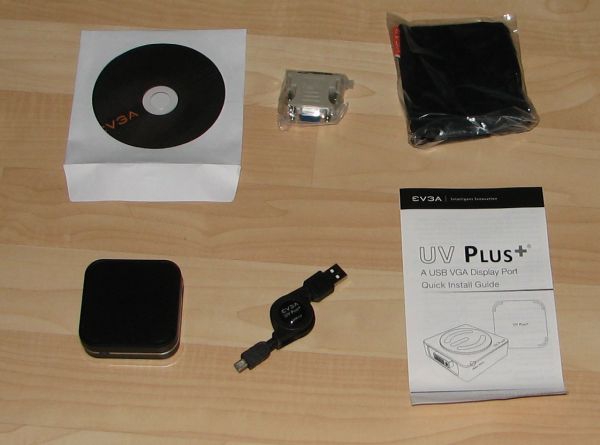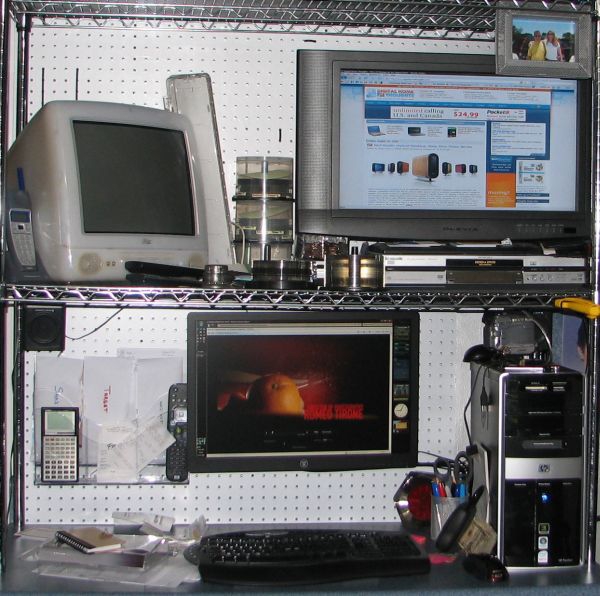Tuesday, September 23, 2008
EVGA's UV-16: Running a Second Monitor Via USB
Posted by Chris Gohlke in "Digital Home Hardware & Accessories" @ 07:00 AM
Long gone are the days when a dual monitor setup was limited to the uber-geek. I’ve used one on and off at work for years whenever my hardware supported it. I’ve wanted to do the same at home, but have never been successful in getting a second video card to work properly. I think it had something to do with the fact that my primary video source was always a video card built in to the motherboard. Over the years I’ve lost the patience to do much work inside the PC case, so I finally gave up. However, since I switched over to Netflix, I’ve been making pretty heavy use of their video streaming which rekindled my desire to have a second display. The Olevia LCD TV in my office has a VGA input, so I just needed a cost effective way to get a second video output.

I’d looked at USB options in the past, but the reviews were pretty poor and the adapters were pretty expensive. Then I came across the EVGA UV-16 and decided to give it a go. So, let’s see if this device can easily get me to dual monitor bliss. The unit itself is pretty small at just 2.5 inches square and has a USB and DVI connection. You also get a retractable USB cable and a small travel pouch (I guess one of the intended uses is for running a projector while on the road). Rounding out the package is a DVI to VGA converter, manual, and driver CD. You need to provide your own video cable.

Image Figure 1: Here is what you get in the box.
Rather than use the drivers included on the CD, I went ahead and got the most current driver from the web. Installation was a snap. I hooked up the monitor and it was auto-detected and installed. Using Vista, I was able to expand my desktop and use the second monitor.
The specs indicate that the UV-16 will support a resolution of up to 1600 by 1200. The same company also makes a cheaper model, the UV-12, that only supports up to 1440 by 900. My Olivia supported a maximum resolution of 1280 by 1040, so I probably could have saved a few bucks and gone with the cheaper one. At that setting, I had no problems running video from Windows Media Center and working on the other screen at the same time. Of note is that the second monitor does not activate until after Windows boots and there is a slight pause to the system while it initializes. I don’t really do any PC gaming, so I can’t comment on its suitability for that, but I doubt it would handle any high-end gaming.
My plan was to use the second monitor primarily for Netflix streaming to allow me to watch movies while working on my primary screen. Unfortunately, this is where things fell apart. The short version is that this device does not support HDCP and Netflix requires it. HDCP is a rant for another day, but after a bit of tweaking, I am able to watch Netflix on my primary monitor and work on my second monitor. However, since my second monitor is really a TV, the picture is nowhere near as good as my primary, so doing a lot of work on it will be uncomfortable and require some rearranging of my workspace.

Image Figure 2: Up and running. Extra credit for guessing what show I am watching.
I debated returning this product, but I decided my fix was good enough temporarily and long term I'll just get a matching monitor to my current one so that I won't mind working on it over USB while using my original connection for content requiring HDCP. You can pick the UV-16 up at Amazon for $81.42 [Affiliate] or its little brother the UV-12 for $69.98 [Affiliate].
Chris Gohlke is a Contributing Editor for Digital Home Thoughts. He loves poker, RPGs, and Sci-Fi and loves to get his hands on real-life tech gadgets. He lives in Tallahassee, Florida, USA with his wife and three cats.












